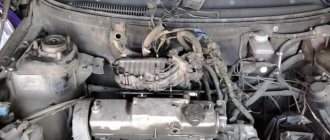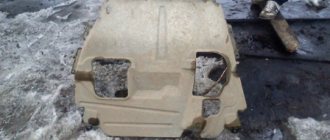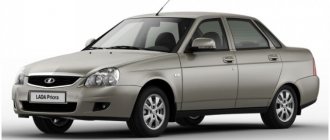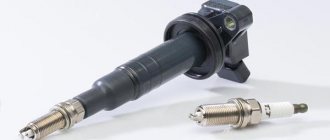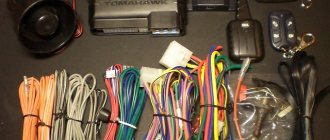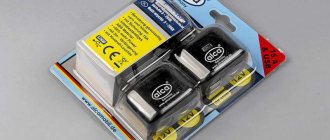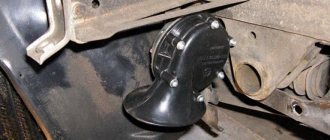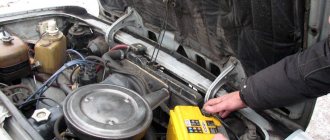It cannot be said that Nissan made a revolutionary breakthrough in 2007, but it was this Japanese automaker that was the first to offer its customers an all-round visibility system. Initially it was offered exclusively as an option. But as it developed, the system from Nissan and other auto companies increasingly began to be included in separate configurations.
If we talk about simple cars in the mid-price range, no one yet offers such equipment as part of the standard equipment. Some automakers cannot even offer all-round visibility as an option. Therefore, it was quite natural for drivers to want to install it themselves.
The modern all-round visibility system is one of the active safety elements of a car. It will be integrated into a multimedia entertainment complex. In fact, this is a new step in the development of parking sensors and parking assistants.
What it is
Before installing a surround view system on a car with your own hands, it would be a good idea to learn in more detail about the features of this equipment and its functionality.
The main task of the system is to demonstrate to the driver through the screen in the vehicle's cabin the current situation that is observed around the car in real time. The presence of all-round visibility helps to simplify complex maneuvers, including parking in extremely limited space or reversing when there are obstacles on different sides.
To ensure functionality, the car system is equipped with special software. It is installed directly into the control unit, which is responsible not only for all-round visibility for a particular vehicle, but also for controlling other active safety systems.
The equipment operates using cameras. To monitor what is happening around the entire perimeter of the vehicle, you need to install at least 4 cameras:
- Front. The most common place for its installation is the radiator grill of the vehicle. But other options are also possible, depending on the specific car and its design features.
- Lateral. At least one camera is installed on the left and right sides of the vehicle. The most convenient installation location is the side mirror housing.
- Rear. It is attached in the license plate area, on the rear bumper and in other areas, depending on the design and model of the car.
Increased demands are placed on such characteristics as the viewing angle of each camera. If it is not large enough, it will not be possible to combine images from all cameras to obtain a panoramic image displayed on the display in the cabin. For better detail, some systems provide more cameras.
During operation of the active safety system, the display in the cabin is often divided into 2 equal parts. On one side, a general view of the car from a panoramic point is displayed, and on the other, the current image of one of the cameras is broadcast. When it comes to reversing, parking or driving onto an overpass, the rear camera is turned on on the second part of the screen.
Since the all-round view works in conjunction with the parking assistant, the interior display also shows graphical information in the form of driving directions, green and red zones. The driver can also receive additional audible warning signals when approaching objects and obstacles.
There are several main modes in which the equipment operates. Some turn on automatically, while others can be activated at the command of the driver himself, depending on what exactly he wants to see on the display at a particular moment.
- Manual mode. Allows you to select which side of the vehicle to display on the display.
- Panoramic mode. When it is turned on, a picture appears on the screen from all available external cameras at once.
- Parking mode. It turns on automatically, without driver intervention. Becomes active when the speed drops to 10-15 kilometers per hour. The screen displays the most optimal trajectory or graphical limiters that change color from green to red (in most cases) as you approach an object or obstacle.
All parking systems with all-round visibility do not require manual activation. They turn on automatically when a certain speed value is reached. When the speed increases, the system also automatically turns off. This allows the driver not to be distracted from driving.
How it works
When the system is activated, the display is usually divided into 2 parts. One of them displays a panoramic image, and the second one displays an image from one of the cameras. Mainly from the back.
The factory all-round visibility system is integrated into the parking sensors, with which interaction is carried out. This allows you to display graphics of the direction of movement on the screen, divide zones into red and green, thereby marking the distance to obstacles. Additionally, the driver is notified by sound signals.
It is important to understand that all-round visibility usually works when driving at relatively low speeds. The system is activated either automatically when driving in reverse gear, or manually using switches in the cabin.
Main advantages
It is really difficult for some motorists to decide on such a purchase, since a set of even the simplest system does not cost that little.
As arguments in favor of installation, it is worth talking about the main advantages of operating a car with an all-round visibility system installed on it. Having such equipment on your car gives you a number of privileges. They are reflected not only in increasing the level of one’s own safety, but also in the ability to protect the life and health of other road users.
By installing such a system, you will receive the following key advantages:
- Possibility of obtaining a permanent panoramic image of your vehicle. Thanks to it, it becomes much easier to control the situation from all sides of the car.
- Separately, you can monitor and control the situation from separate cameras. In this case, the image will have high quality and clarity.
- The process of parking in limited space and in the presence of various kinds of obstacles around is greatly simplified.
- In addition to the video image, the display in the cabin displays auxiliary graphic and visual cues, and an audio assistant can be implemented.
- Depending on the specific surround view system, you can record and save video similar to a regular DVR. Recording is carried out from each camera separately or from all simultaneously, forming a single video recording.
- If an accident or traffic incident occurs, having a video recording everything that happens around you can be an extremely useful and effective tool for proving your own innocence or identifying the culprit of the incident.
In the hands of an experienced auto electrician, installing an all-round view yourself will not be a serious test. But if you have no experience, then you should think about the rationality of trying to install it yourself.
Design of a car's all-round viewing system
All video cameras have high resolution. Thanks to this, it is possible to transmit an image that will have a high degree of detail.
The evolution of optical parking sensors has led to the appearance of all-round visibility. As a result, the rear camera makes parking easier.
For the first time, such an innovation was used on Nissan cars produced in Japan. Then it was picked up by other famous automakers on the planet. We are talking about BMW, Volkswagen, Mercedes, Toyota and others.
What is required for installation
Not all cars even offer the option of installing a factory-installed all-round visibility system. But this is not at all a reason to refuse it, since now there is an excellent opportunity to install the equipment yourself or with the hands of car service specialists.
There are a fairly large number of ready-made kits available for sale that include everything you need. Most of them are universal, although there are also model kits adapted for cars of a specific make and model. Knowing some of the intricacies of self-installation, you can set up a 360-degree view with your own hands. If you want or need to save money on buying ready-made kits, buy individual components.
The main thing here is the result and the interaction of all components with each other.
A kit for creating an all-round visibility system on a car must include the following components:
- Display with electronic filling and software.
- 4 cameras. Moreover, they will differ depending on where they are mounted. The front and rear cameras can be normal parking cameras. They display parking graphic lines, have an average viewing angle and are fairly inexpensive. There is no point in buying any expensive parking cameras in this situation. Just take high-quality products without unnecessary bells and whistles. But to mount cameras on the left and right rear view mirrors, you will need panoramic cameras. They do not display parking lines, since this is not necessary, but the viewing angle here is maximum.
- Tools, various consumables in the form of wiring, glue, clamps, etc.
It’s worth mentioning the displays separately. There are 3 variants of screens with the brains of the all-round viewing system on sale. Which one to choose, decide for yourself.
- A selector for 4 video cameras, with which you can display images from each of them one by one. This display allows the driver to choose which camera image will be displayed on the screen. But such an implementation scheme cannot be called a full-fledged all-round overview.
- A display with hardware and software that simultaneously processes signals from 4 cameras. That is, the driver gets the opportunity to display images from all cameras on the screen, providing control over the situation around the vehicle.
- A display with filling that displays data from all cameras, composes them and creates an image in the format of a panoramic 3D view of the car from above or from a third person. This directly depends on the specific functionality. These are the screens that were created to implement a full-fledged modern all-round viewing system.
Installation recommendations
When everything necessary to install the all-round viewing system has been purchased and assembled, you can begin to work.
- At the first stage, you should determine all the places where the cameras will be located.
- It is recommended to install the rear camera first. You may need to cut a hole for it on the platform intended for fixing the license plate.
- After cutting, sand the area using sandpaper.
- The easiest way to fix the camera itself is with glue that is resistant to weathering and temperature changes.
- Then the front parking camera is mounted in the radiator grille area. For installation, the same principle applies as with the rear camera.
- Then comes the turn of the side cameras. They are mounted in mirrors, and this procedure causes much more difficulties. The mirrors themselves are first dismantled, a hole is made in the body for the camera and fixed in it.
- Using door connectors, the wiring is pulled into the interior. After this, the side mirrors return to their place.
- The wiring from the rear and front cameras also needs to be routed through the interior. Here you should act based on the design features of a particular car, existing technological holes, etc. You will probably have to remove the trunk trim. In the cabin, it is better to stretch along the floor than along the ceiling. It is important that during operation the driver or passenger does not touch the wires and cannot accidentally damage them.
- At the final stage, when the wires are connected to the monitor, the setup is performed. The setup procedure is carried out strictly according to the instructions from the display manufacturer.
Most ready-made kits for all-round viewing provide detailed instructions for connecting, installing and configuring the system.
What machines can it be installed on?
Some motorists who own inexpensive or fairly old cars strongly doubt whether they will be able to install such equipment. And you really need to figure out which cars can have a modern all-round visibility system installed on them.
There are no serious restrictions in this regard. In theory, the equipment can be mounted on any vehicle, regardless of its type, make, model or year of manufacture. The only caveat is the mandatory presence of a multimedia or navigation system with a large display. But monitors can also be purchased separately.
Yes, the equipment will not work or cannot function normally if there are problems with the electrical wiring on the machine, short circuits appear, breaks occur, etc. By connecting the system to such wiring, sensors and cameras can quickly fail. And since the price of even a simple kit is far from small, it is much easier and cheaper to first bring the car’s electrical wiring into proper condition, and only then connect the cameras and display.
In what situations is such equipment useful?
One gets the impression that such equipment can only be used for parking. However, it is not. The range of applications of such devices is much wider and is not limited to parking alone. So, cameras will also help in the following situations:
- When driving through blind intersections. Often, a camera mounted at the level of a car's radiator grill will be able to see much more than the driver. It is capable of ensuring safe passage through intersections with blind spots.
- When driving on narrow streets. Often the driver has to stretch out to his full height and look to see if his car is hitting obstacles in the form of cinder blocks, curbs, parking posts or other cars. This system makes driving in narrow areas easier.
- Orientation on the road. Some novice drivers are so superficially familiar with the dimensions of their car that they do not know how to pass a hole or other obstacle between the wheels. Often they don't even realize how far they are from other cars or medians. The all-round visibility system will make life much easier for amateur drivers.
